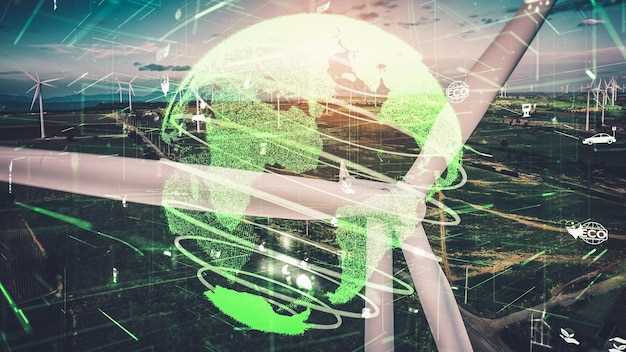
As the world continues to grapple with the challenges posed by the ever-increasing demand for energy, scientists and engineers are tirelessly working towards developing groundbreaking solutions that can revolutionize the way we generate and harness power. This article delves into the realm of emerging technologies in the energy sector, shedding light on the latest trends and innovations that hold immense potential in shaping a sustainable future.
Unleashing the Power of Renewables: One of the most significant developments in the field of sustainable energy is the rapid advancement of renewable technologies. From solar and wind power to geothermal and hydroelectric systems, these innovative solutions are paving the way for a cleaner and greener future. By harnessing the power of natural resources, these technologies offer a viable alternative to traditional fossil fuel-based energy generation, reducing carbon emissions and mitigating the impact of climate change.
Revolutionizing Energy Storage: Another key area of focus in the quest for sustainable energy lies in the development of advanced energy storage systems. As renewable energy sources are intermittent in nature, efficient storage solutions are crucial to ensure a consistent and reliable power supply. Cutting-edge technologies such as advanced batteries, hydrogen storage, and flywheels are being explored to overcome the limitations of traditional storage methods, enabling the seamless integration of renewable energy into the existing grid infrastructure.
Smart Grids and Energy Management: The advent of digital technologies has opened up new avenues for optimizing energy consumption and improving grid efficiency. Smart grids, equipped with advanced sensors and communication networks, enable real-time monitoring and control of energy flow, facilitating the integration of renewable sources and empowering consumers to make informed decisions about their energy usage. Additionally, innovative energy management systems are being developed to optimize energy consumption in buildings, industries, and transportation, further enhancing energy efficiency and reducing wastage.
Exploring the Potential of Nuclear Fusion: Nuclear fusion, often hailed as the “holy grail” of energy production, holds immense promise in providing a virtually limitless and clean source of power. By replicating the process that powers the sun, scientists are striving to unlock the potential of fusion reactions to generate massive amounts of energy without the drawbacks associated with nuclear fission. Although still in the experimental stage, advancements in fusion technology are steadily progressing, offering hope for a future where fusion power becomes a reality.
In conclusion, the field of emerging technologies in sustainable energy is witnessing remarkable advancements that have the potential to reshape the way we generate, store, and manage power. From harnessing the power of renewables to revolutionizing energy storage, and from smart grids to the pursuit of nuclear fusion, these innovations hold the key to a more sustainable and environmentally friendly energy landscape. By embracing these cutting-edge solutions, we can pave the way for a brighter and greener future for generations to come.
Harnessing the Power of Artificial Intelligence in the Energy Sector
In this section, we will explore the immense potential of leveraging Artificial Intelligence (AI) in the energy sector. AI, a cutting-edge technology, has the capability to revolutionize the way we generate, distribute, and consume energy. By harnessing the power of AI, we can unlock new opportunities, optimize operations, and drive sustainable growth in the energy industry.
Transforming Energy Systems: AI has the ability to transform traditional energy systems by enabling smarter decision-making and enhancing efficiency. Through advanced data analytics and machine learning algorithms, AI can analyze vast amounts of data from various sources, such as sensors, smart grids, and weather forecasts, to optimize energy generation and consumption. This can lead to reduced energy waste, improved grid stability, and increased renewable energy integration.
Enhancing Energy Management: AI can play a crucial role in enhancing energy management practices. By utilizing AI-powered predictive analytics, energy companies can accurately forecast energy demand, identify potential bottlenecks, and optimize energy supply. This enables more efficient resource allocation, cost savings, and improved reliability in energy delivery.
Enabling Smart Grids: AI can enable the development of smart grids, which are intelligent energy distribution networks. Through AI algorithms, smart grids can autonomously monitor and control energy flow, detect faults, and respond to changing demand patterns. This results in improved grid resilience, reduced downtime, and enhanced integration of renewable energy sources.
Facilitating Energy Efficiency: AI can facilitate energy efficiency by providing real-time insights and recommendations for energy conservation. By analyzing data from smart meters, building management systems, and IoT devices, AI can identify energy-saving opportunities and suggest optimal energy usage patterns. This empowers consumers and businesses to make informed decisions, reduce energy consumption, and lower carbon footprints.
Advancing Renewable Energy: AI can accelerate the adoption and integration of renewable energy sources. By leveraging AI algorithms, energy companies can optimize the placement and operation of renewable energy assets, such as solar panels and wind turbines. This maximizes energy production, minimizes intermittency issues, and contributes to a more sustainable energy mix.
In conclusion, the application of Artificial Intelligence in the energy sector holds immense potential for transforming energy systems, enhancing energy management practices, enabling smart grids, facilitating energy efficiency, and advancing renewable energy. By embracing AI technologies, the energy industry can pave the way for a more sustainable and resilient future.
Revolutionizing Renewable Energy: The Role of Blockchain Technology
In this section, we will explore the transformative potential of blockchain technology in the renewable energy sector. Blockchain, a decentralized and transparent digital ledger, has the power to revolutionize the way renewable energy is generated, distributed, and consumed. By eliminating intermediaries and enabling peer-to-peer transactions, blockchain can enhance efficiency, security, and trust in the renewable energy ecosystem.
Enhancing Efficiency and Transparency
Blockchain technology can streamline and automate various processes in the renewable energy sector, leading to increased efficiency. Smart contracts, powered by blockchain, can enable automatic execution of agreements between energy producers and consumers, eliminating the need for intermediaries. This not only reduces transaction costs but also ensures faster and more accurate settlements.
Moreover, blockchain can enhance transparency in the renewable energy market. By recording every transaction on a distributed ledger, blockchain provides a transparent and immutable record of energy generation, consumption, and trading. This transparency can help in verifying the origin and authenticity of renewable energy sources, promoting greater trust among stakeholders.
Facilitating Peer-to-Peer Energy Trading
One of the most promising applications of blockchain in renewable energy is peer-to-peer energy trading. With blockchain, individuals and businesses can directly trade excess energy generated from renewable sources with others in their community. This decentralized approach empowers consumers to become prosumers, generating and selling their own energy, while also promoting the use of renewable sources.
Blockchain-based platforms enable secure and transparent peer-to-peer energy transactions, ensuring fair pricing and reducing reliance on centralized energy providers. This not only promotes energy independence but also encourages the adoption of renewable energy technologies at a grassroots level.
In conclusion, blockchain technology has the potential to revolutionize the renewable energy sector by enhancing efficiency, transparency, and enabling peer-to-peer energy trading. As the world seeks sustainable and clean energy solutions, blockchain can play a crucial role in accelerating the transition towards a greener future.
Advancements in Energy Storage: From Batteries to Flywheels
In the realm of energy storage, significant progress has been made in recent years, revolutionizing the way we store and utilize energy. From traditional batteries to innovative flywheel technology, advancements in energy storage have paved the way for a more sustainable and efficient energy future.
1. Breakthroughs in Battery Technology
Battery technology has undergone remarkable advancements, enabling longer-lasting and more powerful energy storage solutions. The development of lithium-ion batteries, for instance, has revolutionized portable electronics and electric vehicles, providing higher energy density and longer lifespan compared to traditional lead-acid batteries.
Furthermore, research is being conducted on next-generation batteries, such as solid-state batteries, which promise even higher energy density and improved safety. These advancements in battery technology are crucial for the widespread adoption of renewable energy sources and the integration of intermittent energy generation into the grid.
2. Harnessing the Power of Flywheels
Another exciting development in energy storage is the utilization of flywheel technology. Flywheels store energy in the form of rotational kinetic energy, offering several advantages over traditional batteries. They have a longer lifespan, require minimal maintenance, and can provide rapid response times.
Flywheels are particularly useful in applications that require short bursts of high-power energy, such as stabilizing the grid during sudden fluctuations in demand or providing backup power during outages. Additionally, flywheels can be combined with renewable energy sources to store excess energy and release it when needed, ensuring a more reliable and stable energy supply.
- Improved Efficiency: Flywheels have high energy efficiency, with the ability to store and release energy with minimal losses.
- Enhanced Grid Stability: By quickly responding to fluctuations in energy demand, flywheels help maintain a stable grid and prevent blackouts.
- Reduced Environmental Impact: The use of flywheels in energy storage contributes to a greener and more sustainable energy system, reducing reliance on fossil fuels.
In conclusion, advancements in energy storage, ranging from batteries to flywheels, are driving the transition towards a more sustainable and efficient energy landscape. These technologies offer improved energy density, longer lifespan, and enhanced grid stability, paving the way for a future powered by renewable energy sources.
The Rise of Smart Grids: Enhancing Efficiency and Sustainability
As the world continues to evolve and seek innovative solutions for a sustainable future, the rise of smart grids has emerged as a promising development in the field of energy management. These advanced systems are revolutionizing the way electricity is generated, distributed, and consumed, with the ultimate goal of enhancing efficiency and promoting sustainability.
Transforming Energy Infrastructure
Smart grids represent a significant shift from traditional energy infrastructure, incorporating cutting-edge technologies and intelligent communication systems. By integrating renewable energy sources, such as solar and wind power, into the grid, these systems enable a more diversified and decentralized energy generation. This not only reduces reliance on fossil fuels but also enhances the overall resilience and reliability of the grid.
Optimizing Energy Consumption
One of the key advantages of smart grids is their ability to optimize energy consumption at both the individual and community levels. Through the use of smart meters and real-time data analysis, consumers can gain insights into their energy usage patterns and make informed decisions to reduce waste and lower their carbon footprint. Additionally, smart grids enable demand response programs, allowing utilities to adjust electricity prices based on peak demand periods, incentivizing consumers to shift their usage to off-peak hours.
Furthermore, smart grids facilitate the integration of electric vehicles (EVs) into the energy ecosystem. By enabling bidirectional energy flow, EVs can not only draw power from the grid but also feed excess energy back into it. This concept, known as vehicle-to-grid (V2G) technology, not only supports the widespread adoption of EVs but also provides a means for energy storage and grid stabilization.
In conclusion, the rise of smart grids presents a transformative opportunity for the energy sector. By enhancing efficiency, promoting sustainability, and empowering consumers, these advanced systems are paving the way for a more resilient and environmentally friendly energy future.
Exploring the Potential of Internet of Things (IoT) in Energy Management
The integration of Internet of Things (IoT) technology in the field of energy management has opened up new possibilities and opportunities for optimizing energy consumption, improving efficiency, and reducing costs. This section delves into the potential of IoT in revolutionizing the way energy is managed and utilized, presenting a glimpse into the future of energy management.
IoT, a network of interconnected devices and sensors, enables the collection, analysis, and exchange of data in real-time. In the context of energy management, IoT offers the ability to monitor and control energy usage across various sectors, including residential, commercial, and industrial. By connecting devices and systems, IoT facilitates the seamless flow of information, enabling intelligent decision-making and automation.
One of the key advantages of IoT in energy management is its ability to provide granular insights into energy consumption patterns. Through the deployment of smart meters, sensors, and connected devices, energy data can be collected at a much more detailed level, allowing for a deeper understanding of energy usage patterns and trends. This information can then be leveraged to identify areas of inefficiency, optimize energy consumption, and implement targeted energy-saving measures.
Furthermore, IoT enables real-time monitoring and control of energy systems, allowing for proactive management and response to fluctuations in energy demand and supply. By integrating IoT technology with renewable energy sources, such as solar panels and wind turbines, energy generation can be optimized based on real-time data, ensuring maximum efficiency and utilization of renewable resources.
In addition to optimizing energy consumption and generation, IoT also plays a crucial role in enhancing energy grid management. Through the use of IoT-enabled devices and sensors, utilities can monitor the health and performance of the grid infrastructure, detect faults or anomalies, and respond quickly to prevent potential disruptions. This level of monitoring and control improves the reliability and resilience of the energy grid, ensuring a stable and uninterrupted energy supply.
Overall, the potential of IoT in energy management is vast and promising. By leveraging the power of interconnected devices and real-time data analysis, IoT has the capability to transform the way energy is managed, leading to increased efficiency, sustainability, and cost savings. As the technology continues to evolve and mature, the integration of IoT in energy management is expected to become more widespread, revolutionizing the energy industry and shaping a greener and smarter future.
Next-Generation Solar Panels: From Efficiency to Aesthetics
Solar panels have come a long way in recent years, evolving from simple energy-generating devices to sophisticated and aesthetically pleasing solutions. This section explores the advancements in solar panel technology, focusing on the improvements in efficiency and the integration of aesthetics.
Enhanced Efficiency for Greater Energy Production
One of the key areas of innovation in next-generation solar panels is the enhancement of their efficiency. Researchers and engineers have been tirelessly working to develop new materials and designs that can maximize the conversion of sunlight into electricity. By improving the efficiency of solar panels, more energy can be generated from the same amount of sunlight, making solar power a more viable and cost-effective option for meeting our energy needs.
Advancements in efficiency have been achieved through various means, such as the development of new semiconductor materials, improved cell architectures, and the integration of advanced tracking systems. These innovations have resulted in solar panels that can capture and convert sunlight more effectively, leading to higher energy yields and increased overall performance.
Aesthetics Integration for Seamless Integration

While efficiency is crucial, the appearance of solar panels is also becoming a significant consideration. In the past, solar panels were often seen as bulky and unattractive additions to buildings. However, next-generation solar panels are designed with aesthetics in mind, allowing for seamless integration into various architectural styles and environments.
One approach to enhancing the aesthetics of solar panels is the use of transparent or semi-transparent materials. These panels can be integrated into windows, skylights, or even building facades, allowing natural light to pass through while simultaneously generating electricity. This integration of solar panels into building elements not only improves the overall appearance but also maximizes the use of available space for energy generation.
Additionally, advancements in solar panel design have led to the development of sleek and slim profiles, making them less obtrusive and more visually appealing. These panels can be seamlessly integrated into rooftops or incorporated into innovative structures, such as solar canopies or solar-powered street furniture, further enhancing their aesthetic appeal.
In conclusion, next-generation solar panels are not only focused on improving efficiency but also on integrating aesthetics into their design. By combining enhanced efficiency with visually appealing features, solar panels are becoming an attractive and sustainable solution for meeting our energy needs while seamlessly blending into our built environment.
